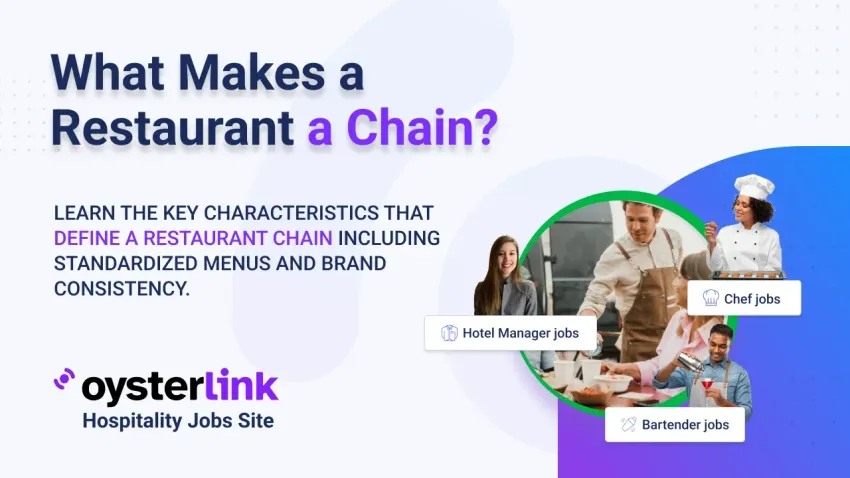What Makes a Restaurant a Chain Key Takeaways:
- A restaurant chain operates multiple locations under the same brand with standardized menus, operations and management systems
- Chains typically have 10+ locations, though some consider 3-5 locations the minimum threshold
- Franchise models allow rapid expansion while maintaining brand consistency
Ever wondered what transforms a single restaurant into a chain? Is it the number of locations, the standardization of the menu, or something else?
In this article, we’re diving deep into what makes a restaurant a chain, and we’ll also explore the critical elements that set chains apart from independent restaurants—using examples you might recognize!
How Restaurant Chains Transformed the Food Industry
The rise of chain restaurants has completely transformed the way we think about dining. From McDonald's to Starbucks, these iconic brands aren’t just about food—they’re about an experience that is consistent, efficient and accessible.
The power of chain restaurants lies in their ability to deliver the same menu, quality and atmosphere every time, no matter where you are in the world. But how did these brands become so successful, and why are they now an integral part of our daily lives?
The answer comes down to a few key factors:
1. Why Consistency Is Crucial in Restaurant Chain Success
.png)
When you walk into a McDonald's, Subway, or Starbucks, you already know what to expect. That familiarity is no accident—it’s at the very core of what makes chain restaurants so successful. Consistency is not just about food; it’s about creating an experience that’s the same every time, regardless of location.
At its most basic level, consistency builds trust. Customers know exactly what they’re going to get, whether they’re ordering a Big Mac in New York or a Cappuccino in Paris. This dependability transforms dining from a mundane task into something customers can rely on, which keeps them coming back.
Consistency isn’t just about the menu; it’s also about service, ambience and quality control. A chain restaurant works hard to ensure the food tastes the same every time, the service is up to standard and the environment feels just as welcoming.
2. How Restaurant Chains Achieve Efficiency at Scale
.png)
One of the defining characteristics of chain restaurants is their ability to scale rapidly while maintaining high operational efficiency. It’s not just about having more locations; it’s about managing them well.
Behind every successful chain is a robust system that ensures efficiency in everything from food preparation to staffing and inventory management. To make this work, chain restaurants rely on standardized operational systems that allow them to run smoothly across multiple locations.
Whether it's an employee training program, inventory logistics, or kitchen procedures, these systems ensure that operations are optimized and consistent across thousands of stores. This efficiency is a key reason why chains can scale at such a fast pace.
From supply chain management that guarantees quality ingredients at the lowest cost, to point-of-sale systems that streamline transactions, every part of the operation is finely tuned to keep things running smoothly. This is what allows chains to expand rapidly while keeping the customer experience consistent and efficient, no matter how many locations they open.
3. How Restaurant Chains Build Brand Recognition and Customer Trust
.png)
When you see the golden arches of McDonald’s or the green logo of Starbucks, you know exactly what you're getting. That instant recognition is the power of branding at its finest. The visual elements—logos, color schemes, store layouts—are all carefully designed to create a familiar, cohesive experience that reinforces the brand’s identity.
Branding goes far beyond logos, though. It’s about the emotions and associations a brand creates in the minds of consumers.
For example, when you think of Starbucks, you may think of a cozy environment, a place to unwind, or a premium coffee experience.
When you think of McDonald's, you may recall affordability, quick service, or family-friendly dining. This consistency in branding is crucial because it ensures that customers recognize and feel comfortable with the brand, wherever they are in the world.
This emotional connection to the brand leads to brand loyalty, where customers return not just for the food, but because the brand has become a part of their daily lives. Strong brand recognition means customers are more likely to choose a familiar chain over an unfamiliar independent restaurant, even when other options are available.
4. How Restaurant Chains Expand Without Compromising Quality
.png)
The expansion of chain restaurants is a carefully orchestrated process that balances growth with maintaining quality. Successful chains follow strategic expansion plans that focus on the right markets, locations and customer bases.
These brands don’t just open stores randomly—they first research market demographics, competition, real estate and brand positioning to ensure each new location will be successful.
Chains often focus on saturating specific geographic regions before branching out nationally or internationally. This allows the brand to build operational efficiencies and brand recognition in a specific area before expanding into new markets.
This strategic approach helps chain restaurants create a strong, loyal customer base in each region, which in turn supports their broader growth efforts. Also, many chains adopt a hybrid expansion model where they operate some corporate-owned locations while franchising others.
This gives the brand the ability to grow rapidly without having to fund every new location themselves, while still maintaining a certain level of control over key markets.
5. How Restaurant Chains Use Technology to Stay Connected and Scalable
.png)
In today’s fast-paced world, chain restaurants can’t rely solely on traditional operations. They need to embrace technology to keep everything running smoothly and efficiently. Whether it’s for customer engagement, inventory management, or operational efficiency, technology plays a critical role in the modern chain restaurant landscape.
For starters, point-of-sale (POS) systems and mobile apps allow customers to order quickly and efficiently, while providing chains with real-time data to help manage operations.
Inventory management systems help track stock levels across multiple locations, ensuring that every restaurant has what it needs to meet demand without overstocking.
Data analytics is another major topic. By collecting and analyzing data from all locations, chains can understand customer preferences, track sales trends and optimize their offerings. For example, a chain like Chipotle can use data to understand which menu items are most popular in different regions, allowing them to adjust their menu accordingly and stay ahead of trends.
Technology also helps streamline the customer experience, from ordering online to loyalty programs that reward repeat business.
What Makes a Restaurant Chain Successful? Final Insights
The chain restaurant revolution has reshaped the dining landscape by emphasizing consistency, efficiency and scalable growth. These brands succeed because they’ve perfected the balance between standardizing operations, maintaining strong brand identity and using data to drive decisions.
For those in the industry, OysterLink provides the tools to connect with top talent and advance careers in the restaurant and hospitality sectors. Whether you're hiring or seeking new opportunities, OysterLink is a trusted resource for industry professionals.









Loading comments...